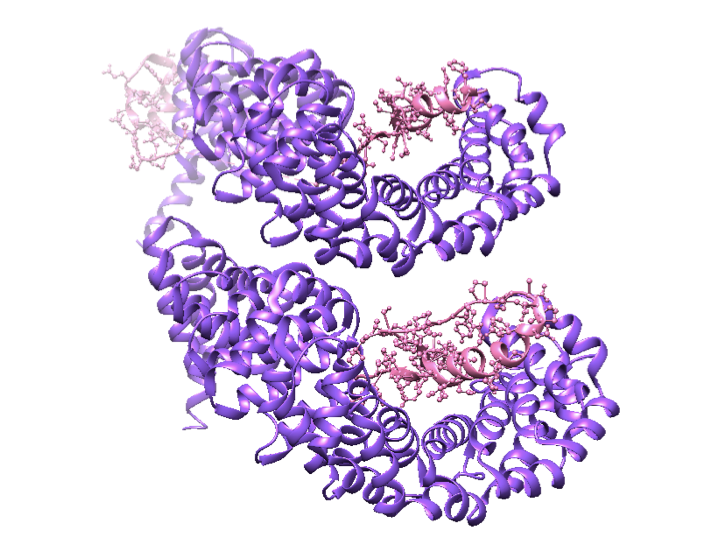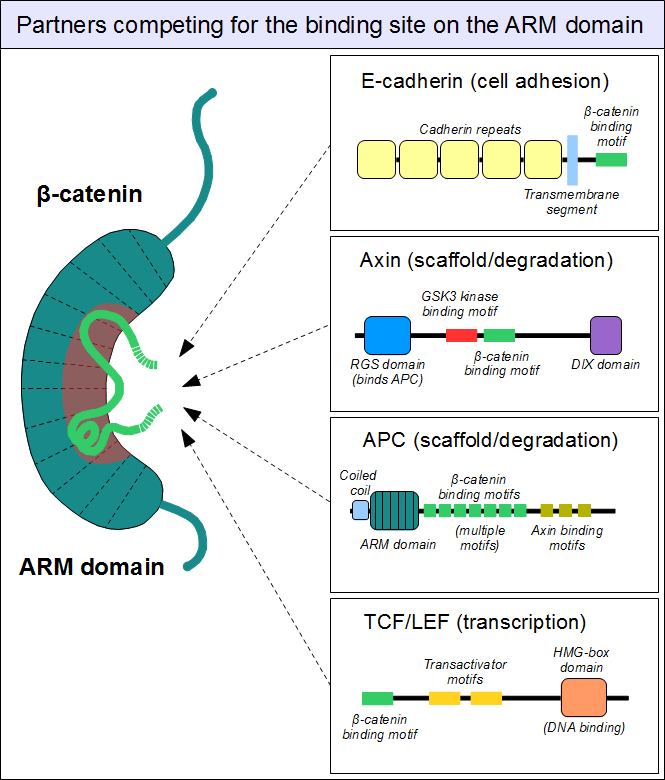Oncology Beta-Catenin - Oncologia Beta-Catenina
Introduction
Beta-Catenin is a cellular protein with a dual role: on the one hand, it mediates contact inhibition mechanisms by being part of the multi-proteic complex that connects caderine to actin filaments, on the other hand, it is able to bind other proteins forming a transcriptional complex that, if it reaches the nucleus, is able to guide the expression of some genes important for the proliferation of epithelial cells (pro-proliferative function).
Beta-Catenin

When the cell must not proliferate, the free cytoplasmic -catenin is bound to the cytoplasmic protein APC and the complex that is formed gives rise to a process of inactivation of the -catenin itself which cannot then reach the nucleus and activate the genes involved in duplication processes.
APC is a protein encoded by the apc gene that plays a key role in the family polyposis of the colon. Patients suffering from this pathology experience the appearance of hundreds of polyps (benign mucosal tumors) on the inner surface of the colon and around the age of 25-30 years, at least one of these polyps evolves towards malignancy giving rise to a carcinoma of the colon.
The disease is due to mutations of the apc gene in regions that encode for the domain of the -catenin binding protein but the mutations may also affect regions that are involved in the binding of the APC protein with other proteins that, together with -catenin, are part of a large inactivatory cytoplasmic complex.
In addition to free -catenin and APC, the complex includes axin (structural protein) and two kinases including GSK3 (glycogen-synthase kinase 3) which, when part of this complex, is able to phosphorylate -catenin which, once phosphorylated, is recognized by ubiquitinization systems and then degraded in the proteasome.
In patients with polyposis family of the colon, however, -catenin cannot be degraded (due to lack of formation of the complex) and is transported to the nucleus where it acts as a transcriptional factor.
If, in a healthy cell, proliferation is to be activated, the transcriptional factors of the family Wnt that bind and activate the receptors Frizzled to 7 transmembrane domains that in turn determine the disassembly of the APC-mediated complex and therefore the release of the -catenin that can go to the nucleus to act as a transcriptional factor come into play.
In the family polyposis of the colon, being APC-mediated, all this does not happen because the complex is always disassembled.

Although APC is not only present in the cells of the colon, the mutation causes cancer here due to the particular conformation of the mucosa. The lining epithelium of the colon is constantly being remade and is organized in villi and crypts. The villi, the site of the exchange for the absorption of nutrients, are composed of cells that age, die and are then released within the intestinal lumen. The crypts are instead formed by stem cells and are therefore the site of the replication process that maintains the epithelial component of the villus. The continuous proliferation occurs thanks to the activity of the stromal cells that continue to produce Wnt growth factors leaving the -catenin free to act as a transcriptional factor. Stem cells progressively duplicate, one cell remains stem and the other progenitor begins to migrate to the surface of the villus, and in this way, moving along this gradient, the cell moves away from Wnt growth factors and progressively acquires the phenotype in which the -catenin is switched off and thus stops proliferation. The cells at this point are completely differentiated and lose their mitogenic activity.
If APC has changed, however, the cells, moving away from the crypts, continue to maintain a proliferative attitude and stop between crypt and villus, resulting in the formation of a benign mass that may undergo further mutations and give rise to a carcinoma.
The mutation of APC is recessive and therefore, if a subject inherits a mutated allele there will be no phenotypic effect but, when the second allele goes to heterozygosity loss, the cell can perform the pro-cancerous function.
Phenotypically similar results can be obtained by acting not only on APC but also on other proteins involved:
- if a non-phosphorylated mutated -catenin is present, it cannot be degraded by the proteasome and therefore will always trigger proliferation; or -catenin may be over-expressed and capture by the complex may not be sufficient.
- If Wnt is present in abundance, the complex will always be disassembled and -catenin will always be free to act;
- axin mutations (often large deletions) at the level of regions that bind APC, kinase or -catenin prevent complex formation.

Introduzione
La Beta-Catenina è una proteina cellulare dotata di un duplice ruolo: da un lato media i meccanismi di inibizione da contatto essendo parte del complesso multiproteico che collega la caderina ai filamenti di actina, dall’altro, è in grado di legare altre proteine formando un complesso trascrizionale che, se raggiunge il nucleo, è in grado di guidare l’espressione di alcuni geni importanti per la proliferazione delle cellule epiteliali (funzione pro-proliferativa).
Beta-Catenina

Quando la cellula non deve proliferare, la -catenina libera citoplasmatica viene legata alla proteina citoplasmatica APC e il complesso che si forma dà origine ad un processo di inattivazione della -catenina stessa che quindi non può arrivare al nucleo e attivare i geni coinvolti nei processi duplicativi.
APC è una proteina codificata dal gene apc che gioca un ruolo fondamentale nella poliposi famigliare del colon. I pazienti affetti da questa patologia vanno incontro alla comparsa di centinaia di polipi (tumori benigni della mucosa) sulla superficie interna del colon e intorno ai 25-30 anni, almeno uno di questi polipi evolve verso la malignità dando origine ad un carcinoma del colon.
La patologia è dovuta a mutazioni del gene apc ricadenti in regioni che codificano per il dominio della proteina legante la -catenina ma le mutazioni possono anche riguardare regioni che sono coinvolte nel legame della proteina APC con altre proteine che, insieme alla -catenina, fanno parte di un grosso complesso citoplasmatico inattivatorio.
Oltre alla -catenina libera e all’APC infatti nel complesso sono presenti l’axina (proteina strutturale) e due chinasi tra cui la GSK3 (glicogeno-sintasi chinasi 3) che, quando fa parte di questo complesso, è in grado di fosforilare la -catenina che, una volta fosforilata, viene riconosciuta dai sistemi di ubiquitinizzazione e degradata quindi nel proteasoma.
Nei pazienti affetti da poliposi famigliare del colon però la -catenina non può essere degradata (per mancata formazione del complesso) e viene trasportata al nucleo dove funge da fattore trascrizionale.
Nel caso in cui, in una cellula sana, si voglia attivare la proliferazione, entrano in gioco i fattori trascrizionali della famiglia Wnt che legano e attivano i recettori Frizzled a 7 domini transmembrana che a loro volta determinano il disassemblaggio del complesso APC-mediato e quindi la liberazione della -catenina che può andare al nucleo a svolgere la funzione di fattore trascrizionale.
Nella poliposi famigliare del colon, essendo APC mutato, tutto questo non avviene perché il complesso si trova sempre disassemblato.

Nonostante APC non sia presente solo nelle cellule del colon, la mutazione determina tumore in questa sede a causa della particolare conformazione della mucosa. L’epitelio di rivestimento del colon è in continuo rifacimento ed è organizzato in villi e cripte. I villi, sede degli scambi per l’assorbimento dei nutrienti, sono composti da cellule che invecchiano, muoiono e vengono poi liberate all’interno del lume intestinale. Le cripte sono invece formate da cellule staminali e sono quindi la sede del processo replicativo che mantiene la componente epiteliale del villo. La continua proliferazione avviene grazie all’attività delle cellule stromali che continuano a produrre fattori di crescita Wnt lasciando la -catenina libera di agire da fattore trascrizionale. Le cellule staminali progressivamente duplicano, una cellula rimane staminale e l’altra progenitrice incomincia a migrare verso la superficie del villo, e in questo modo spostandosi lungo questo gradiente, la cellula si allontana dai fattori di crescita Wnt acquisendo progressivamente il fenotipo in cui la -catenina viene spenta e quindi si arresta la proliferazione. Le cellule a questo punto sono completamente differenziate e perdono la loro attività mitogena.
Se APC è mutato però le cellule, allontanandosi dalle cripte, continuano a mantenere un atteggiamento proliferativo e si arrestano tra cripta e villo determinando la formazione di una massa benigna che potrà andare incontro ad ulteriori mutazioni e dare origine ad un carcinoma.
La mutazione di APC è recessiva e quindi, se un soggetto eredita un allele mutato non ci sarà effetto fenotipico ma, quando il secondo allele andrà incontro a perdita di eterozigosi, la cellula può svolgere la funzione pro-cancerogena.
Si possono ottenere risultati fenotipicamente simili agendo non solo su APC ma anche su altre proteine coinvolte:
- se è presente una -catenina mutata non fosforilabile, non può essere degradata dal proteasoma e quindi attiverà sempre la proliferazione; oppure la -catenina può essere overespressa e la cattura da parte del complesso può non essere sufficiente.
- se Wnt è presente in abbondanza, il complesso sarà sempre disassemplato e la -catenina sempre libera di agire;
- mutazioni a carico dell’axina (spesso grosse delezioni) a livello di regioni che legano l’APC, la chinasi o la -catenina impedisce la formazione del complesso.

Fonti-Sources
Immagini-Pictures
!discovery 30
This post was shared and voted inside the discord by the curators team of discovery-it
Join our community! hive-193212
Discovery-it is also a Witness, vote for us here
Congratulations @riccc96! You have completed the following achievement on the Hive blockchain and have been rewarded with new badge(s) :
You can view your badges on your board And compare to others on the Ranking
If you no longer want to receive notifications, reply to this comment with the word
STOPDo not miss the last post from @hivebuzz:
Thanks for your contribution to the STEMsocial community. Feel free to join us on discord to get to know the rest of us!
Please consider supporting our funding proposal, approving our witness (@stem.witness) or delegating to the @stemsocial account (for some ROI).
Please consider using the STEMsocial app app and including @stemsocial as a beneficiary to get a stronger support.